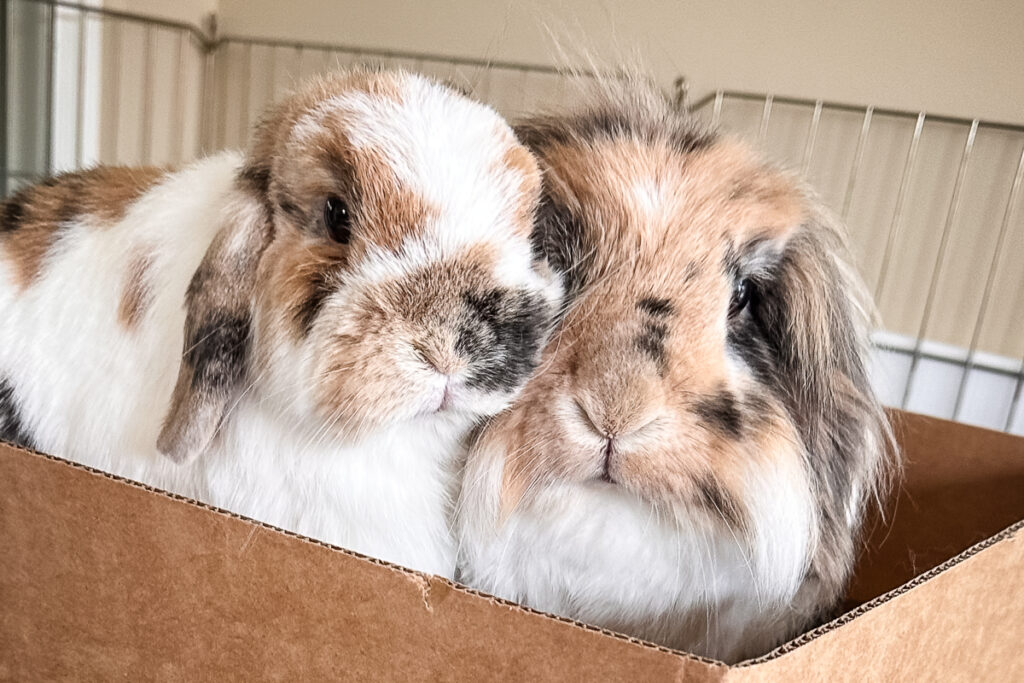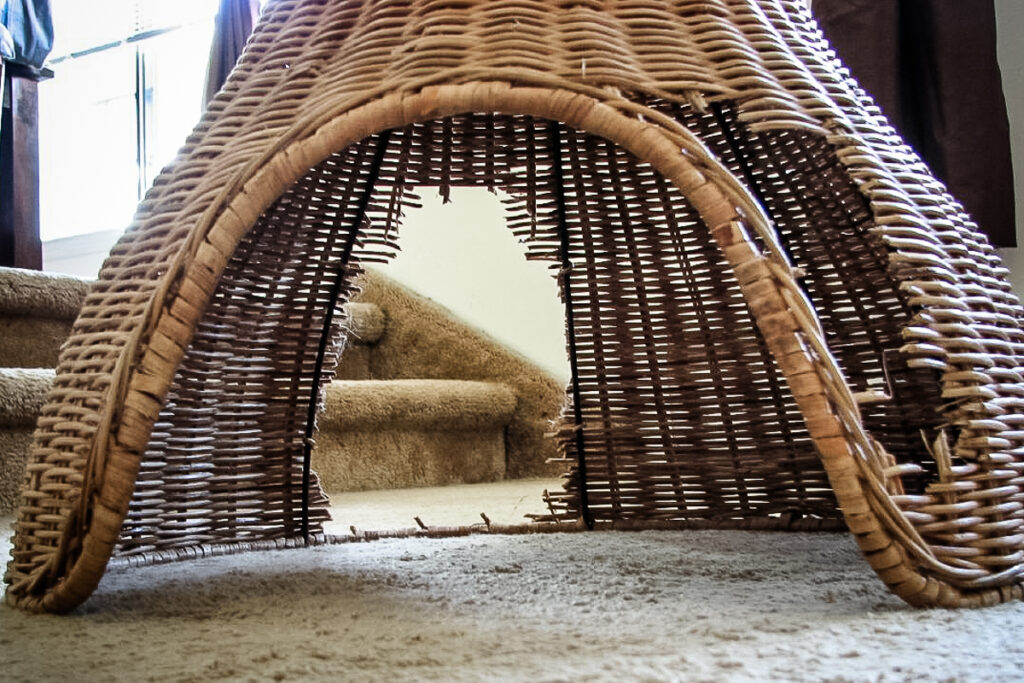One afternoon many years ago while lounging at an outdoor cafe, a newtonian apple fell on my head. As a first-time rabbit person in that primitive [pre-house-rabbit] era, I had been pondering how to make our home bunny-safe. The [breeding-centric] “Raise Rabbits for Fun and Profit” type literature made no mention of Trixie’s fondness for electric cords. My gaze fell on a bicycle chained to a nearby parking meter. The chain was enclosed in substantial but flexible translucent plastic tubing. I rubbed my head, took a bite of the apple, and went to a nearby hardware store. I found what I needed in the plumbing-supply department: plastic tubing in a variety of diameters and thicknesses. I bought lengths of several sizes, and went to work with X-acto knife and electrical tape. I fine-tuned my great discovery as I observed Trixie’s interactions with it, but the real revelation was the means rather than the end.
Wandering aimlessly has always been my special skill, and finally it had borne fruit. Soon I was meandering aisles at moving-and-packing stores (cardboard in infinite forms), import stores (all things wicker), craft stores (raffia, baskets), liquor stores (boxes), building-supply stores. Specialty stores (and websites) encourage creative thinking because they have lots of stuff you’ve never seen and therefore have no preconceived notions about.
Protect, Prevent, Provide
Rabbits, finding themselves living in a human-created environment, adapt in creative ways. With no twigs or branches to snack on (and get necessary fiber in their diet), they turn to those thin chewable lengths snaking along the floor. Dark and quiet burrows await them under the humans’ sleeping area. Nests are fashioned from carpet and drape.
Many inventions and adaptations were created to protect rabbits from harm, which often calls for preventing access to dangerous items. Once both rabbit and household furnishings are protected, we turn our restless monkey-mind to providing safe alternatives.
Chew-chew ch-bunny
Many adaptations are related to chewing. This normal, necessary, and natural bunny behavior can be fun for all parties-or a total disaster.
To protect your home and your bunny from endangering each other, a few of the many products house-rabbit people have adapted include flexible tubing (mentioned above) and black corrugated tubing (electronics and auto supply stores) to cover cords, and cord clips to move them off the floor. [Check out our many bunny proofing tips.]
A favorite safe chewable is cardboard. This versatile material comes in dozens of shapes and sizes; it’s also inexpensive or even free. By blocking forbidden chewables with a permitted material we prevent, protect, and provide alternatives all with one trip to a packing-supplies store.

Cardboard boxes placed under the bed protect the underside of your bed while giving Bunny a chewing environment almost as appealing as your boxspring. Cardboard cylinders placed between wall and sofa-back prevent access to cords and baseboards and provide a tunnel. These treasures (sold to the uninitiated as concrete forms) come in several diameters at home-improvement and building-supply stores (Missouri educator Joy Gioia reminds us to buy the ones without an interior waxed coating).
[A rescuer in Georgia] combines internet sleuthing with recycling and fundraising. “I live in a big city and through an internet search found a farm five miles from my house. I harvest apple branches for free in January-the owner is delighted that I come and pick up his pruned branches. I give them to my own ‘chewers’ and send some home with new adopters. I am getting fewer chewing complaints, as well as many requests for more branches, for which we charge a minimal sum.”Education saves lives and is a major endeavor for [rabbit rescuers.] Arkansas educator Sharon Dumas writes, ” I use ‘Chewy Louie,’ a puppet who pops out of a basket. In the basket is an assortment of items chewed by rabbits (a magazine, a remote control, a portion of bunny-damaged electrical cord). I exchange each of these with things that are okay for Chewy Louie to chew-a basket, sections of wood, pine cones, and electrical cord en-cased in plastic tubing.”
Digging outside the box
Another house-bunny necessity that has fueled the creative spark is litterboxes. They may use the basic box designed for cats, but our burrowing bunnies have a tendency to scatter litter. This has led to a spate of adaptation ideas. [An Indiana rescuer] uses grates from sink dish-drainers and plastic canvas material used in needlepoint. Judith Pierce suggests lighting grids used for fluorescent ceiling lights. Several volunteers recommend hardware cloth. Nancy LaRoche of Colorado writes, “We cut it to fit the bottom of the litter box, drill tiny holes through the litter box in the corners, so we can tie the mesh in, and then put the litter on top of it. When bunnies’ nails hit the mesh, they quit digging.” Kristi Cole uses cookie-cooling racks.
Another adaptive approach is to use plastic tubs deeper than conventional litterboxes. Supposedly designed to mix concrete or other uninteresting purposes, they allow diggers to indulge their passion with minimal spill-over.
Judith Pierce makes every day a holiday with an ingenious discovery (see photo). “These round, plastic boxes with comfy handles are sold during the holidays. Meant to store holiday ornaments, they are perfect litterboxes for bunny pairs. At Christmas, I pick up 5 or 6 and either use them myself or sell them to my bunny-sitting customers. They’re easy to carry, a good size for two bunnies, deep enough to hold lots of hay but not too deep to make them hard to get into.
Ground? Floor? Inquiring buns want to know
As grazing creatures who live in underground burrows, rabbits are naturally inclined to snack on and attempt to dig floor coverings. Our mission: find flooring that is easy to clean, safe or impossible to chew and dig yet still appealing to Thumper.
Coroplast (corrugated+plas-tic) is a sturdy plastic sheet used to make signs and several types of packaging. Similarly, tileboard is a melamine-coated hardboard used for walls. Both fit all our parameters. Long-time [rescuer} Holly O’Meara uses plastic mats designed to go under office chairs as flooring for “puppy pens.”
Playtime
Toys range from the built-from-scratch to appropriated toys and objects designed for other species. Small cardboard tubes packed with hay safely satisfy the need to chew. Plastic toys designed for human babies can be chewed as well as tossed and nudged. Look for hanging toys of hemp and wood in the birds section of your neighborhood pet-supply store (one that doesn’t sell live animals).
Florida [rescuer] Marielle Gomez-Kaifer devised a toy that provides mental exertion along with physical exercise-a winning combo to stave off boredom-induced mischief. “I use a box within a box, putting the openings at right angles to one another so the bun has a bit of a maze to get to an inner box with hay and a few raisins.”

